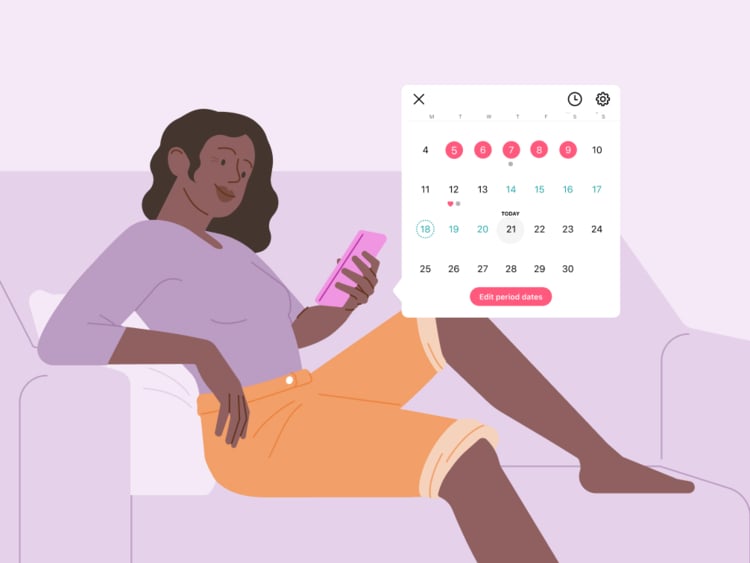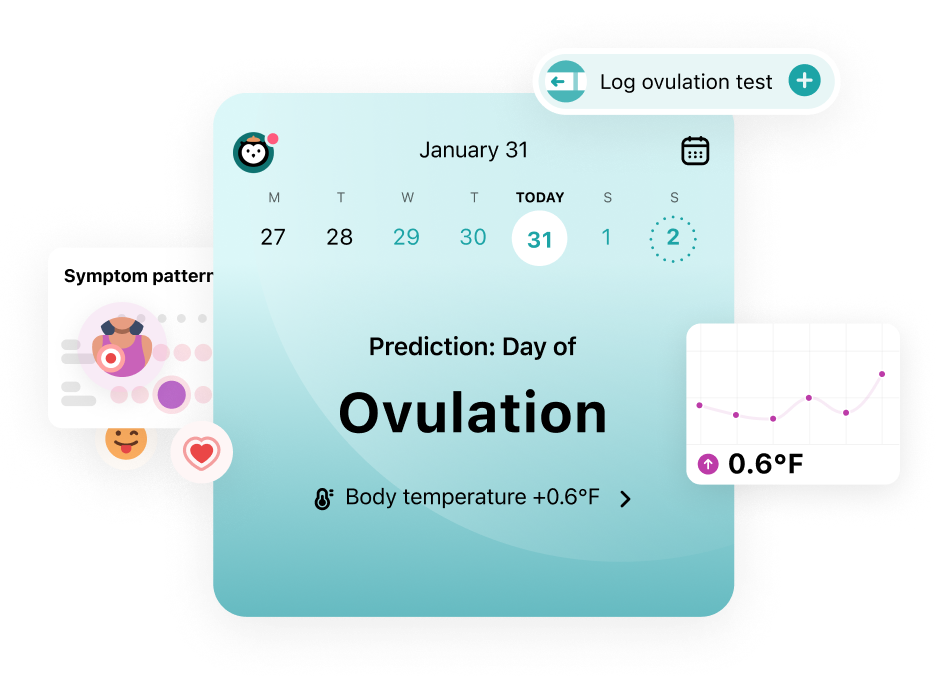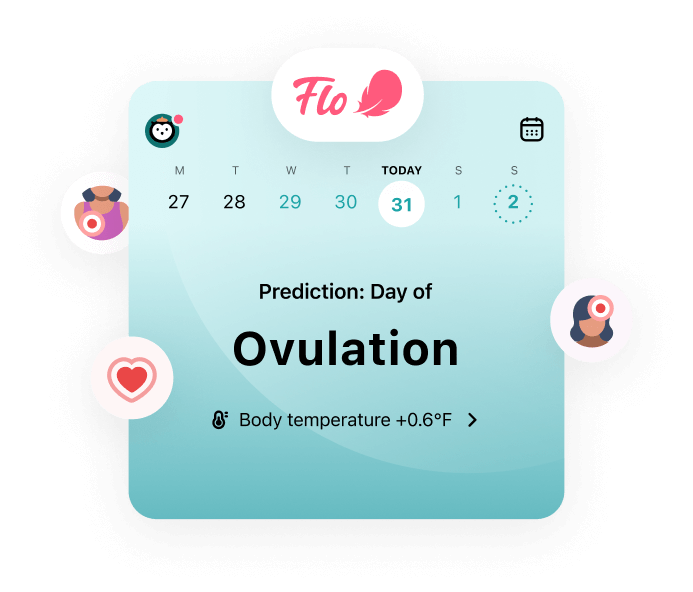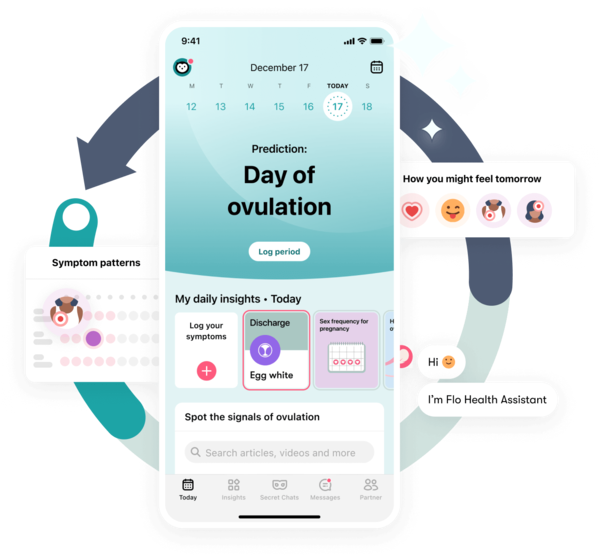Find out how long ovulation lasts and all the signs it may be over until your next cycle.
-
Tracking cycle
-
Getting pregnant
-
Pregnancy
-
Help Center
-
Flo for Partners
-
Anonymous Mode
-
Flo app reviews
-
Flo Premium New
-
Secret Chats New
-
Symptom Checker New
-
Your cycle
-
Health 360°
-
Getting pregnant
-
Pregnancy
-
Being a mom
-
LGBTQ+
-
Quizzes
-
Ovulation calculator
-
hCG calculator
-
Pregnancy test calculator
-
Menstrual cycle calculator
-
Period calculator
-
Implantation calculator
-
Pregnancy weeks to months calculator
-
Pregnancy due date calculator
-
IVF and FET due date calculator
-
Due date calculator by ultrasound
-
Medical Affairs
-
Science & Research
-
Pass It On Project New
-
Privacy Portal
-
Press Center
-
Flo Accuracy
-
Careers
-
Contact Us
8 signs ovulation is over for this month


Every piece of content at Flo Health adheres to the highest editorial standards for language, style, and medical accuracy. To learn what we do to deliver the best health and lifestyle insights to you, check out our content review principles.
If you’re trying to conceive (TTC), ovulation is likely never far from your mind. It’s a big event, after all, because having sex around ovulation (the release of an egg) boosts your chances of getting pregnant.
But it’s not always easy to tell when ovulation has happened and when your fertile window has likely closed for the month. Obstetrician and gynecologist Dr. Angela Jones, US, is on hand to demystify this part of the cycle.
Key takeaways
- Ovulation happens when one of your ovaries releases an egg into your uterine (fallopian) tubes. The egg can only last up to 24 hours, but this short moment can be a big deal if you’re trying to conceive.
- As sperm can live for up to five days in the female body, there are around six days each cycle when your pregnancy chances are highest. This is your fertile window. It closes 12 to 24 hours after ovulation.
- You might be able to tell that ovulation is over by noticing body changes, such as breast tenderness stopping, a change in your basal body temperature, and your cervical mucus becoming thick and creamy. But everyone is different, so it’s helpful to get to know your normal.
- A cycle-tracking app like Flo can help take the guesswork out of ovulation. Ovulation test kits are a reliable way of determining whether you’re about to ovulate.
- Your pregnancy chances will be low 24 hours after ovulation because your egg can only survive in your uterine tube for one day.
- Knowing when ovulation is over can help you better understand your body and pinpoint when to next have sex for the best chances of conception.

 Over
7.8M
ratings averaging
4.8/5
*
Over
7.8M
ratings averaging
4.8/5
*
Understand your fertility better with the Flo app
- Learn more about your fertility signals
- Improve ovulation predictions by tracking temperature via Apple Watch
- Log your ovulation test results
 Over
7.8M
ratings averaging
4.8/5
*
Over
7.8M
ratings averaging
4.8/5
*

Trying to conceive?
The Flo app can help you better understand your fertility

 Over
7.8M
ratings averaging
4.8/5
*
Over
7.8M
ratings averaging
4.8/5
*
Understand your fertility better with the Flo app
- Learn more about your fertility signals
- Improve ovulation predictions by tracking temperature via Apple Watch
- Log your ovulation test results
8 signs ovulation is over
Knowing when you’ve ovulated can give you peace of mind that you’ve timed sex during the most fertile part of your cycle. And there are clues your body may give you that ovulation is likely over (and you’re now in the luteal phase of your cycle, which is the lead-up to your period if you haven’t got pregnant), says Dr. Jones.
But remember, not everyone experiences these symptoms. Tracking your symptoms using an app like Flo can help you spot your personal patterns so you know what to expect throughout your cycle. Some of the signs ovulation is over may be:
Cervical mucus becomes thick and creamy again
Around ovulation, you might notice your cervical mucus (also called vaginal discharge) becomes clear and slippery — a bit like egg whites. Once this most fertile part of your cycle is over, your discharge tends to become thicker, stickier, and creamier.
“This is one of the most obvious signs ovulation is over,” says Dr. Jones.
Breasts no longer feel tender
The hormonal shifts around ovulation can affect your breast tissue, making it feel more tender than normal. So if you usually experience sore boobs during your fertile days, once this tenderness stops, you can probably assume ovulation is done for the month. That said, some people experience breast pain right up until they get their period, so it’s not always a totally reliable signal that your fertile period is over.
Sex drive is lower
Having more desire for sex during your fertile days can be common. Hormonal shifts around this time often come with a boosted sex drive, and some people find that this returns to baseline once ovulation is over. So, if you were desperate to tear your partner’s clothes off a few days ago but not so much today, that could mean ovulation is over for the month. And remember, everyone is different, so if you don’t notice any changes in your sex drive throughout your cycle, that’s also totally fine.
Ovulation cramps have eased
Up to 40% of us experience pain during ovulation (called mittelschmerz), which can feel like a sharp twinge or cramps in your lower belly. It typically lasts a few hours or up to 24 hours. So if you usually feel a need for a hot water bottle around ovulation, but then the cramps seem to pass, that gives you a pretty big clue that ovulation has happened. Around 5% of us also experience a little bit of bleeding (spotting) during ovulation. So if you’ve noticed that your spotting has stopped, that might also suggest that ovulation is done for the month.
Your cervix feels firmer
If you feel comfortable doing so, touching your cervix can also help you figure out whether you’ve ovulated or not. However, it’s much better (and easier) to rely on other methods of ovulation tracking, such as monitoring your basal body temperature (BBT), using ovulation tracking kits, and keeping an eye on the way your cervical mucus changes.
If you do want to check your cervix throughout your cycle, it can be helpful to use some lube. Gently guide your longest finger into your vagina and feel for a round, raised circle with a dimple in the middle. Once you’re used to checking your cervix regularly, you might notice that your cervix feels firm and sits lower (closer to your belly) during the parts of your menstrual cycle when you’re not ovulating (during your follicular and luteal phases and your period). During your fertile window, your cervix might feel softer, a bit like your ear lobe.
Your body temperature increases a little
If you’ve been trying for a baby for a while, you might already be a pro at taking your basal body temperature each morning as soon as you wake up. And according to Dr. Jones, this can be a useful sign that ovulation has happened. “A change in basal body temperature is another major sign ovulation has happened as it increases slightly during ovulation.”
You can record your daily readings on a spreadsheet or an app like Flo. Your BBT increases very slightly (by around (0.5° to 1°F) during ovulation and for around three days afterward. So if you notice a peak on your chart, ovulation has likely happened.
It’s roughly two days after a positive LH test
Ovulation predictor tests can also be really helpful when you’re TTC. They measure a surge in a luteinizing hormone (LH) in your pee. If it’s been a few days since you got a positive reading on an ovulation predictor kit, it’s safe to assume your fertile window has likely been and gone.
Take a quiz
Find out what you can do with our Health Assistant
When is ovulation, and how long does it last?
Ovulation is the point in your menstrual cycle when your ovaries release a mature egg. Once it’s released, the egg moves down your uterine tube and hangs around there for up to 24 hours, waiting for a potential meeting with a sperm.
This can mean pregnancy if your egg meets sperm during that time. But if the sperm fails to show and fertilization doesn’t happen, your egg will eventually disintegrate or break down, and you will get your period, which is the shedding of the lining of your uterus.
Even though ovulation is technically just the moment of egg release, there are several days in your cycle when getting pregnant is likely, explains Dr. Jones.
As sperm can live for up to five days in the female body after sex (and your egg lives for up to 24 hours), that adds up to around six days per cycle when your pregnancy chances are highest. This is known as your fertile window. “To increase your chances of pregnancy, having sex during your fertile window is crucial,” Dr. Jones explains.
In an average 28-day menstrual cycle, ovulation tends to happen about 14 days before your next period. That said, we’re all different with different cycle lengths, and the exact timing of ovulation can range from person to person. Research shows that a textbook 28-day cycle isn’t as common as people think. But keeping track of your periods with a calendar or an ovulation-tracking app like Flo can help you learn about your ovulation signs and, therefore, when you’re probably most fertile.

Can you get pregnant after ovulation is over?
Knowing whether you’ve ovulated or not can give you a little more certainty during your TTC journey. But you might be wondering whether pregnancy is possible if you have sex after ovulation has passed.
“Generally, the chances of getting pregnant after ovulation are low,” explains Dr. Jones. “And though it’s still possible to conceive, your fertile window is limited to the 12 to 24 hours after your egg has been released.”
So, if it’s been more than a day since you ovulated, your pregnancy chances are likely to be slim. “Your chances of getting pregnant will increase if you wait until your next fertile window,” suggests Dr. Jones. If you want some help tracking your cycle, download the Flo app and get started.
Experts recommend having sex every other day during your six-day fertile window for your best chances of conception success. But that doesn’t mean you shouldn’t have sex if you want to at other points. Having regular sex (regardless of where you are in your cycle) can build closeness with your partner and stop sex from feeling like a chore if you’re TTC.
Frequently asked questions about ovulation
What happens on the last day of ovulation?
Ovulation technically happens in just one day. It’s when your ovaries release an egg into your uterine tubes to potentially be fertilized by a sperm. Your egg can survive for up to 24 hours after ovulation. But as sperm can live for around five days in the female body, there are around six days per cycle when your pregnancy chances get a boost. This six-day period is called your fertile window.
Is the last day of ovulation when you’re most fertile?
Studies show that you’re most likely to conceive in the few days before you ovulate. One research study found that the chance of pregnancy if you have sex two days before ovulation is 33% compared to 8% the day after ovulation.
How can you tell if your egg was fertilized?
Most people don’t feel fertilization. You might feel a dull ache or experience light spotting around the time that implantation happened, but it can be different for everyone. It’s best to wait until you miss a period (or at least two weeks after you likely ovulated) to do a pregnancy test to confirm. We know it can be hard to hold out, but testing too early can give an inaccurate result, so sit tight.
How long does it take to get pregnant after ovulation?
Once ovulation has happened, your egg can survive for up to about 24 hours in your uterine tube. So the chances of pregnancy are still high if you have sex during this time window. Although it’s not exactly an easy journey from the vagina to the uterine tubes, it doesn’t take long for sperm to swim through the female reproductive tract to fertilize an egg. Studies show that egg and sperm can meet within 15 to 45 minutes after ejaculation.


Hey, I'm Anique
I started using Flo app to track my period and ovulation because we wanted to have a baby.


The Flo app helped me learn about my body and spot ovulation signs during our conception journey.


I vividly
remember the day
that we switched
Flo into
Pregnancy Mode — it was
such a special
moment.
Real stories, real results
Learn how the Flo app became an amazing cheerleader for us on our conception journey.
References
“Basal Body Temperature for Natural Family Planning.” Mayo Clinic, 10 Feb. 2023, www.mayoclinic.org/tests-procedures/basal-body-temperature/about/pac-20393026.
“Breast Pain (Mastalgia).” Johns Hopkins Medicine, www.hopkinsmedicine.org/health/conditions-and-diseases/mastalgia-breast-pain. Accessed 24 Sep. 2024.
“Cervical Mucus.” Cleveland Clinic, https://my.clevelandclinic.org/health/body/21957-cervical-mucus. Accessed 20 July 2022.
Colombo, Bernardo, and Guido Masarotto. “Daily Fecundability: First Results from a New Data Base.” Demographic Research, vol. 3, no. 5, 6 Sep. 2000, p. 39, www.demographic-research.org/volumes/vol3/5/3-5.pdf.
“Conception.” Cleveland Clinic, https://my.clevelandclinic.org/health/articles/11585-conception. Accessed 23 Sep. 2022.
Dasharathy, Sonya S., et al. “Menstrual Bleeding Patterns among Regularly Menstruating Women.” American Journal of Epidemiology, vol. 175, no. 6, Mar. 2012, pp. 536–45, doi:10.1093/aje/kwr356.
Faust, Louis, et al. “Findings from a Mobile Application-Based Cohort Are Consistent with Established Knowledge of the Menstrual Cycle, Fertile Window, and Conception.” Fertility and Sterility, vol. 112, no. 3, Sep. 2019, pp. 450–57.e3, doi:10.1016/j.fertnstert.2019.05.008.
“Fertility Awareness-Based Methods of Family Planning.” The American College of Obstetricians and Gynecologists, Aug. 2022, www.acog.org/womens-health/faqs/fertility-awareness-based-methods-of-family-planning.
Grieger, Jessica A., and Robert J. Norman. “Menstrual Cycle Length and Patterns in a Global Cohort of Women Using a Mobile Phone App: Retrospective Cohort Study.” Journal of Medical Internet Research, vol. 22, no. 6, June 2020, doi:10.2196/17109.
“How to Get Pregnant.” Mayo Clinic, 11 Dec. 2021, www.mayoclinic.org/healthy-lifestyle/getting-pregnant/in-depth/how-to-get-pregnant/art-20047611.
Kerin, J. “Ovulation Detection in the Human.” Clinical Reproduction and Fertility, vol. 1, no. 1, Mar. 1982, pp. 27–54.
“Luteal Phase.” Cleveland Clinic, https://my.clevelandclinic.org/health/articles/24417-luteal-phase. Accessed 5 Sep. 2024Ogle, Alicia. “Using Ovulation Tools to Predict Fertility.” Mayo Clinic Health System, 13 June 2023, www.mayoclinichealthsystem.org/hometown-health/speaking-of-health/using-ovulation-kits-to-predict-fertility.
“Ovulation.” Cleveland Clinic, https://my.clevelandclinic.org/health/articles/23439-ovulation. Accessed 17 Feb. 2023.
“Ovulation Pain.” Cleveland Clinic, https://my.clevelandclinic.org/health/diseases/9134-ovulation-pain-mittelschmerz. Accessed 15 Aug. 2024.
Parenteau-Carreau, S., and C. Infante-Rivard. “Self-Palpation to Assess Cervical Changes in Relation to Mucus and Temperature.” International Journal of Fertility, vol. 33 suppl., 1988, pp. 10–16, pubmed.ncbi.nlm.nih.gov/2902020/.
“Pregnancy Tests.” Cleveland Clinic, my.clevelandclinic.org/health/diagnostics/9703-pregnancy-tests. Accessed 24 Sep. 2022.
Raperport, Claudia, et al. Proov Confirm for Ovulation Confirmation. National Institute for Health and Care Excellence, 6 June 2023, www.nice.org.uk/advice/mib322/resources/proov-confirm-for-ovulation-confirmation-pdf-2285967685437637.
Settlage, D. S., et al. “Sperm Transport from the External Cervical Os to the Fallopian Tubes in Women: A Time and Quantitation Study.” Fertility and Sterility, vol. 24, no. 9, Sep. 1973, pp. 655–61, doi:10.1016/s0015-0282(16)39908-3.
Thiyagarajan, Dhanalakshmi K., et al. “Physiology, Menstrual Cycle.” StatPearls, StatPearls Publishing, 2022, www.ncbi.nlm.nih.gov/books/NBK500020/.
Van Stein, K. R., et al. “Ovulatory Shifts in Sexual Desire but Not Mate Preferences: An LH-Test-Confirmed, Longitudinal Study.” Evolutionary Psychology, vol. 17, no. 2, May 2019, https://doi.org/10.1177/1474704919848116.
Witt, Barry. “Trying to Get Pregnant? Here’s When to Have Sex.” The American College of Obstetricians and Gynecologists, Aug. 2023, www.acog.org/womens-health/experts-and-stories/the-latest/trying-to-get-pregnant-heres-when-to-have-sex.
History of updates
Current version (15 October 2024)
Published (16 October 2024)
In this article

Get your personal guide to fertility
-
Learn how to read your body's ovulation signals
-
Find daily conception tips from our experts
-
Chat with others who are trying to get pregnant




